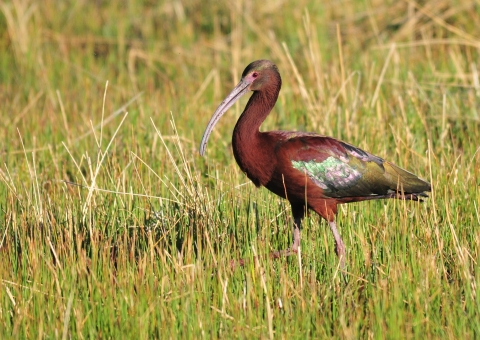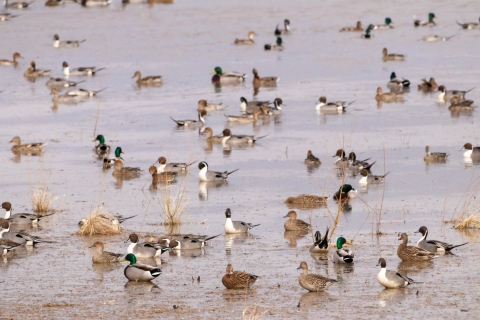Seasons of Wildlife
Winter
In late winter, bald eagles dot trees on the shoreline of any water source, snow geese mass in the thousands, hundreds of trumpeter swans bugle their return from near extinction. You may spot a coyote traveling across frozen wetland units and otters popping up from breaches in the ice with dinner in hand. Spend a few moments in one of the wooded areas and you will likely be greeted by the checkered black, white and red flash of the red-headed woodpecker or hear their characteristic tapping on a tree nearby.
Spring
As spring migration begins- typically late February to early March - waves of white and blue snow geese descend into the refuge. It is not uncommon to see more than 100,000 snow geese undulating in unison over large opening in the ice. As more openings in the ice emerge in mid-March, the monochromatic colors of winter are replaced by the flashy plumes of green-winged teal, northern pintails, norther shovelers, canvasbacks, redheads and mergansers. While watching ducks dabble and dive, don’t forget to look up. Wood ducks pay be perched above your head, searching for nesting locations in tree cavities above the water.
In the late spring, commotions of American coots arrive. They can be seen milling around the waters edge, tending to stay near tall vegetation. If water level conditions allow for emergent vegetation to persist through the summer, you might see strange looking orange, fluffy coot chicks! Hiding in the same tall vegetation you may even spot a sora, bittern or rail. April and May are also the time to strain your eyes, necks and ears for migrating warbler species.
Summer
Late May to early June, you might spot ibis. By June, summer residents are more typical in the wetland areas. Squadrons of American white pelicans often dominate the landscape, but keen observers will also find black-crowned night-heron nesting among lush wetland vegetation. You’ll likely see bright yellow prothonotary warblers nesting among the swampy bottomland forest areas during the summer months. Wood duck broods are commonly seen along creeks and ditched in the area. Brilliantly blue indigo buntings are frequently seen on roadsides and grassland areas.
By July, seasonal wetlands give way to mudflats as flood waters retreat. These areas are typically teaming with shore birds. From July through September, look for sandpipers, plovers and dowitchers. You’re also likely to spot gulls and terns.
Fall
Fall rains usher in the fall migration. From October through late November, wetlands are filled with the calls and quacks of dabbling and diving ducks. The refuge is home to 28 species of waterfowl and migration typically peaks in November. In December most to the waterfowl have moved south. Northern Harriers, short-eared owls and red-tailed hawks are often easy to spot cruising the landscape.
Featured Species
Emiquon National Wildlife Refuge serves as a temporary home to thousands of waterfowl that feed and rest on their annual spring and fall migration. When seasonally flooded the North and South Globe Units along with the Wilder Tract and Oxbow provide a mix of prime habitat for diving ducks and dabbling ducks. The refuge is home to 28 species of waterfowl. The area is also known for significant wood duck nesting. Waterfowl surveys in the wider Emiquon area show average one-day peak abundance of 71,450 ducks with historic peaks as high as 1.5 million!
In addition to waterfowl, the low water during summer drawdowns and the resulting mudflats attract many species of shorebirds, especially sandpipers along with gulls and terns. May and August can be the best time to see many shorebird species. In late summer, the showy white flowers of the federally threatened decurrent false aster can occasionally be seen in disturbed areas left behind by the flood pulses of the river. Dense wetland vegetation provides shelter and feeding habitat for marsh birds such as bitterns, rails, herons and egrets. The wider Emiquon area regularly supports more than 2% of the entire North American population of American Coots, particularly during fall migration. Federally endangered species such as the least tern and piping plover have been spotted during migration.
Emiquon National Wildlife Refuge hosts more than 100 species of songbirds at various times of the year, because of the diverse habitats. Significant tracts of bottomland forest support specialist species during periods of both nesting and migration. Notable species include: prothonotary warblers, red-headed woodpeckers, pileated woodpeckers and rusty blackbirds. In the drier upland forests, it is common to hear and see a different group of passerines, wood thrushes, ovenbirds and cardinals being among the more common species. Edge species, like flycatchers, can often be seen across the refuge perched along the water’s edge. Open grassland support short-eared owls, dickcissel, and grasshopper sparrows. The variety of habitats also support a diverse population of charismatic species including river otters, beavers, bobcats, the federally endangered Indiana bats and monarch butterflies.


